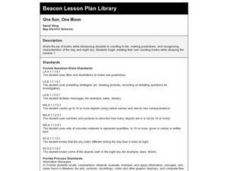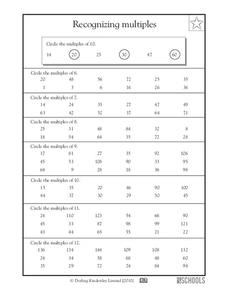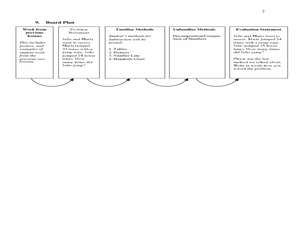Utah Education Network (UEN)
Geo Shapes
Invite your first graders to compose and decompose two and three-dimensional figures with this fun, hands-on lesson. They investigate and predict the results of putting together and taking apart two-dimensional shapes with rubber bands...
Curated OER
Numbers 1-10
Students identify and interpret all the numbers between one and ten. Students count to ten and place the numbers one to ten in order. Students create flashcards for each number, one to ten. Students draw their 10 favorite things.
Curated OER
One Sun, One Moon
First graders read "Ten Black Dots" by Donald Crews and then create their own counting books focusing on the number 1 (one) and using yellow dots to represent the sun, moon and stars.
Curated OER
Counting From 1 to 100
The instructions on this 100-chart direct pupils to "circle odd or even numbers," which is pretty ambiguous. However, children can use it to identify odd or even numbers, practice skip counting, or recognize number patterns.
Curated OER
Recognizing Equivalent Fractions
These 10 equivalent fractions are each missing a number. There isn't much to this activity, but if you're looking for some practice problems you've found them. Encourage kids to draw the process into each, since the numbers are large and...
Curated OER
Noun Recognition Practice #1
In this nouns worksheet, students learn to recognize nouns in sentences. Students read ten sentences and look for the person or place or thing. Students write down the nouns they find in each sentence.
Curated OER
Recognizing Types of Sentences
Use this grammar worksheet to help your young writers with sentence variety. Middle schoolers determine if the sentences are simple, compound or complex sentences. There are eleven questions on this page.
Curated OER
Recognizing Types of Sentences
Determine if sentences are simple, compound, or complex in this grammar worksheet. Young grammarians write the sentence type on the line under each of eleven sentences.
Curated OER
Recognizing Types of Sentences
Examine eleven sentences and identify them as simple sentences, compound sentences, or complex sentences in this grammar worksheet. Use the activity as a quiz, review lesson, or homework assignment.
Curated OER
Recognizing Multiples
Can your fourth graders recognize multiples of 10? What about 11 and 12? Use this worksheet to enhance your multiplication lesson, or to assess what your math students already know about finding multiples. Given six sets of numbers, they...
EngageNY
Solving Percent Problems III
What happens when combining percentage discounts? The last lesson in a series of 29 introduces the idea of combining discounts one after another. Pupils wrestle with the claim that to find the total discount, they need to only add...
Curated OER
What's Next?
Teach the class how to continue a given number pattern, and have them state a rule to explain their answer. Arithmetic sequences and related worksheets are used to reinforce the concept of numerical patterns using the nthterm.
Lions Clubs International Foundation
Mindful Self-Awareness Exercise: Recognizing Strengths
Learners think of something they're good at and reflect on how they feel about it. Pupils then think of ways to be even better at it and set a mental goal to practice.
Curated OER
Connect the dots from 1 to 10
In this connecting the dots worksheet, students recognize numbers one to ten in sequence. Students connect the nine dots.
Curated OER
Mathematics Lesson Plan
Second graders study subtraction facts. In this mathematics instructional activity, 2nd graders discuss how to solve two digit subtraction problems. Students recognize that there are many different methods or strategies one can use such...
Curated OER
Word Scramble: Grade Two Vocabulary List 1
In this recognizing vocabulary words in a list one worksheet, 2nd graders unscramble the list of words. Students rewrite 15 words.
Curated OER
Using Tens Frames for One to One Counting
Students complete a variety of exploratory exercises regarding counting through 10. They recognize the numbers 0-10 as represented using the quinary pattern on the tens frames. They are able to visualize the patterns for future...
Curated OER
The Battle for Ultimate Power
Students gain an understanding of how the powers of 10 and scientific notation can be used to represent the scale of things in the universe. They relate the number of stars in the universe to the number of grains of sand on Earth's beaches.
Missouri Department of Elementary
Are You Balanced?
Balance scales create a strong visual of how an individual prioritizes one's self alongside their commitments to the community, school, and home. Scholars complete a graphic organizer then discuss their findings with their peers. A...
Curated OER
Level Two ITIP (DM)
Students, while working in groups, recognize how to use a decision making process to make positive and healthy decisions concerning health issues. They brainstorm reasons for choosing drugs, witness a decision making power point and...
Ontario
Reading Informational Text
Learning to recognize the importance of the features of information text (i.e., titles, subtitles, endnotes, sidebars, etc.) is the focus of a reading activity designed for middle schoolers. Learners examine how these text features...
Inside Mathematics
Quadratic (2006)
Most problems can be solved using more than one method. A worksheet includes just nine questions but many more ways to solve each. Scholars must graph, solve, and justify quadratic problems.
Illustrative Mathematics
Find The Numbers 0-5 or 5-10
In need of math station or center for your kindergartners? Model how to play this game with the whole class first and then make it into a center. Create a few sets of six number cards with 0-5 or 5-10 and then create a matching die with...
Curated OER
Counting by 3s, 4s, and 5s
Can learners recognize the pattern in these number sequences? Here's a hint: it's skip counting by either three, four, or five. There are three examples at the top demonstrating each of these, and scholars complete 15 number sequences to...























